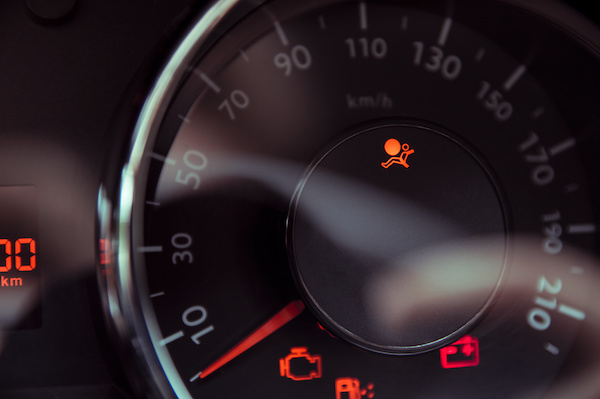What Does SRS Mean In A Car?
Ever noticed the SRS light glowing on your car’s dashboard and wondered what it signifies? That little light is more than just an ornamental feature; it’s a vital part of your vehicle’s safety system.
If you’ve ever found yourself puzzled by this mysterious acronym, you’re not alone. The SRS light is a crucial component of your car’s safety apparatus, linked to the airbag system. When it lights up, it signals a potential issue that might need a technician’s attention. In this guide we will find out the meaning of SRS in a car, its function, and why it’s so essential for your safety on the road.

What Does SRS Mean In A Car?
In a car, “SRS” stands for Supplemental Restraint System. This system is a key part of a vehicle’s passive safety features, designed to enhance the effectiveness of seat belts and provide protection in the event of a collision. The primary components of the SRS include:
-
Airbags: The most well-known part of the SRS, airbags are designed to inflate rapidly during a collision to provide a cushion that helps protect passengers from striking interior objects such as the steering wheel, dashboard, or windows.
-
Sensors: These detect collision forces that indicate a severe impact and determine whether to deploy airbags and at what intensity, based on the severity of the crash and factors such as the occupant’s position and whether they are wearing a seatbelt.
-
Seat Belt Pretensioners: These automatically tighten the seat belts to pull occupants back into their seats and away from the impact area just before and during a collision, ensuring that the belts are at their most effective during the moment of impact.
-
Control Module: This serves as the brain of the SRS, processing information from various sensors and deciding when to activate the airbags and pretensioners.
The SRS is designed to work in conjunction with the primary restraint system—the seat belts—to provide the best possible protection against injury in a crash.
Why Does The SRS Light Come On In My Car?
The SRS light coming on in your car indicates a potential issue with the Supplemental Restraint System (airbags, seatbelts, sensors). There are several reasons why this might happen, and it’s important to get it checked by a mechanic to diagnose the problem and ensure your safety system is functional. Here are some common reasons:

- Faulty Sensors: Your car has various sensors that monitor airbag deployment and seatbelt tension. A malfunctioning sensor can trigger the SRS light even if there’s no other problem.
- Low Battery Power: The SRS system might have a backup battery to maintain memory even when the car is off. If this battery is weak or dead, the SRS light might illuminate.
- Airbag Clock Spring: This is a component that allows the steering wheel to turn while maintaining electrical connections for the airbag. Wear and tear can cause malfunctions here, triggering the light.
- Water Damage: If your car has been exposed to water damage, it could affect SRS components like the control module, leading to warning light activation.
- Deployment After Accident: If your car was previously involved in an accident where the airbags deployed, the SRS system might not be reset properly, causing the light to stay on.
Can You Drive With The SRS Light On?
Technically, you can drive with the SRS light on, but it’s strongly discouraged for your safety. Here’s why:

-
Uncertain Airbag Functionality: The SRS light indicates a potential problem with the airbag system. This means there’s a chance the airbags might not deploy during a collision, which could leave you vulnerable to serious injuries.
-
Risk of Malfunction: In some cases, a malfunctioning SRS system could even cause unintended airbag deployment, which can also be dangerous.
-
Legal Repercussions: Depending on your location, driving with a malfunctioning SRS system might be against the law and could result in fines during vehicle inspections.
How Much Does It Cost To Fix The SRS Light?
The cost to fix an SRS light can vary depending on several factors, including:
- Cause of the problem: Different issues causing the light to turn on will require different repairs, and some parts are more expensive than others.
- Type of car: Labor costs and parts prices can vary depending on the make and model of your car.
- Repair shop: Dealerships typically charge more for labor than independent mechanics.
Here’s a general idea of the cost range:

- Simple fixes: Diagnosing and resetting the code due to a minor issue might cost around $100.
- Sensor replacement: Replacing a faulty sensor could range from $100 to $400.
- Clock spring replacement: This can cost anywhere between $80 and $400.
- Airbag replacement: In the worst-case scenario, replacing an airbag can be expensive, ranging from $1,000 to $2,000.
Frequently Asked Questions
Will airbags go off if the SRS light is on?
When the SRS light is on, it indicates a failure within the airbag system. In the event of a crash, one or maybe all of your airbags might not work. It’s crucial to get this addressed immediately for safety reasons.
Can I drive with SRS light on?
You should avoid driving if the SRS light is on. The light indicates a problem with the airbag system, which can compromise safety in a collision. If the SRS light illuminates before you start driving, it is best to call a qualified mechanic immediately.
How to diagnose SRS light?
To diagnose the SRS light, connect an OBD device to your vehicle’s diagnostic port. Turn the ignition key to the “On” position without starting the engine. Using the OBD device follow the on-screen instructions to navigate to the airbag system menu and select the option to read the error codes.
Where is the SRS sensor located?
The SRS computer module, which includes the SRS sensor, is usually located under the center console between the two front seats or in the center of the dash on the floor. In most GM produced cars, it can be found under the driver or passenger seat.

Hi! I’m Larry Gibbs, studying mechanical engineering with a focus on cars. I really love Ferraris and write blog posts about the latest car stuff. When not studying or blogging, I’m usually on a road trip exploring new places. I also enjoy playing football and watching movies. Life’s an adventure, and I’m all about enjoying the ride!






